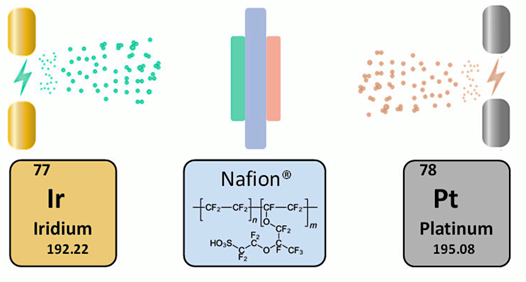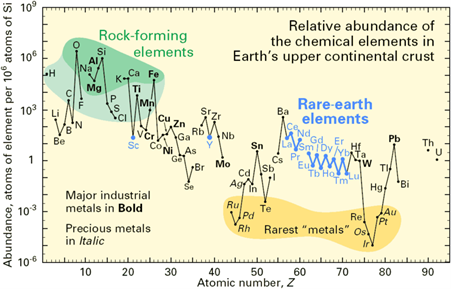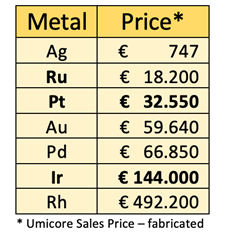Spark Ablation: new method to make Ir and Pt coated membranes with 5 times less noble metal for water electrolysis
Proton-exchange-membrane (PEM) electrolyzers represent standard technology for sustainable hydrogen production, owing to their efficiency and load flexibility. However, the acidic nature of the medium in which the PEM electrolyzer operates requires that expensive noble metals such as platinum and iridium are used as electrocatalysts. Apart from its high cost, the scarcity of iridium is a real bottle neck, as the annual production volume of this metal is “less than a truck load.”
Iridium is the least abundant metal on earth
From: G.B. Haxel, S. Boore, S. Mayfield; USGS;
http://pubs.usgs.gov/fs/2002/fs087-02/
Since low-cost replacements for Ir are not available at present, there is an urgent need to engineer catalyst-coated membranes (CCMs) with homogeneous catalyst layers at low Ir loadings. Efforts to realize this mainly rely on the development of advanced Ir nanostructures with maximized dispersion via wet chemistry routes.
In this study, lead author Foteini Sapountzi from Syngaschem, together with a team from VS Particle In Delft and collaborators from DIFFER and from Fontys demonstrate the potential of an alternative vapor-based process, based on spark ablation and impaction, to fabricate efficient and durable Ir- and Pt-coated membranes.
The encouraging results indicate that spark-ablation can reduce the Ir demand by up to five times compared to commercial CCMs, without compromising their activity. Together with the advantages of simplicity, cost and environmental footprint in the production, the tests indicate that spark ablation may become an attractive method for the manufacture of It and Pt-coated PEM membranes for electrolysis.
Article:
“Spark Ablation for the Fabrication of PEM Water Electrolysis Catalyst-Coated Membranes”
Foteini M. Sapountzi, Marek Lavorenti, Wilbert Vrijburg, Sofia Dimitriadou, Beata Tyburska-Pueschel, Peter Thüne, Hans Niemantsverdriet, Tobias V. Pfeiffer and Mihalis N. Tsampas
https://doi.org/10.3390/catal12111343
Published on November 8, 2022





